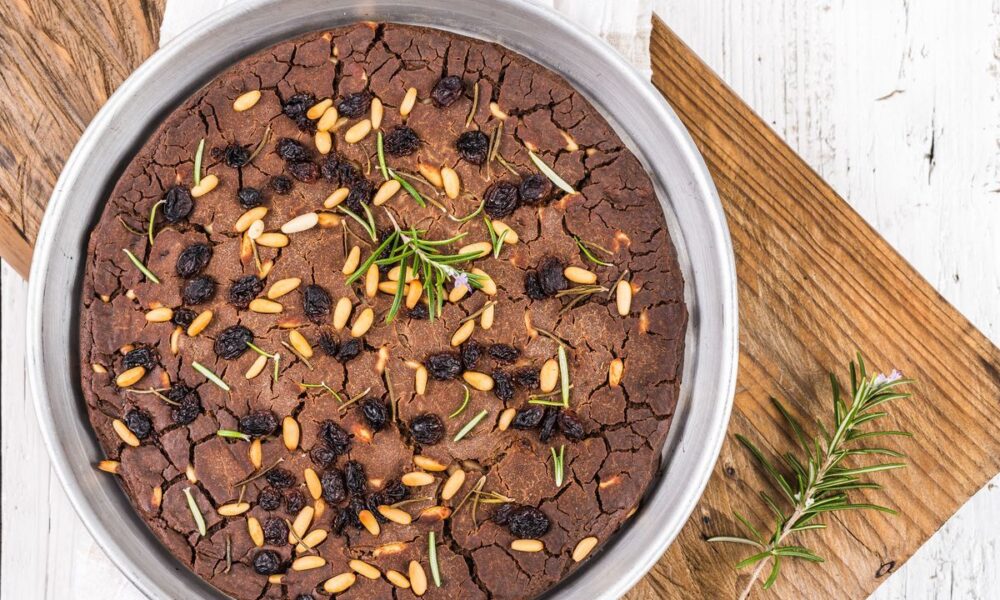Recipes
Chestnut

The Tuscan castagnaccio is a very particular traditional dessert, made with chestnut flour, pine nuts, raisins and walnuts.
Today we are going to Tuscany , a land with a great culinary tradition and exporter of quality in the world, to make a typical dessert of the area: castagnaccio. This dessert is also called pattona or baldino and is prepared with a base of chestnut flour to which pine nuts, walnuts and raisins are added.
Even today it is difficult to trace the true origins of this recipe, especially since the main ingredient, chestnuts , are a typical product of other regions, especially Piedmont. Yet, tradition has it that the Tuscan castagnaccio has its roots in Siena , where it spread starting from the sixteenth century. Let's see how to make this fantastic typical dessert!
How to prepare the Tuscan chestnut recipe
- Sift the chestnut flour into a bowl and begin adding the water , stirring continuously with a whisk and being careful to avoid the formation of any lumps.
- Once you have obtained a rather homogeneous mixture, add the raisins soaked in water, the pine nuts and the shelled and chopped walnuts (keep aside a teaspoon each for decoration).
- Finally, add the sugar and extra virgin olive oil . Continue mixing until the ingredients are well blended together.
- At this point, pour the mixture into a well-greased 30 cm diameter baking pan . Distribute the walnuts and pine nuts kept aside and the rosemary needles on the surface.
- Cook in a preheated oven at 180° for about 40 minutes .
We recommend serving it, once cold, with ricotta and chestnut honey just as Tuscan tradition dictates. Among the other sweet recipes with chestnut flour, we recommend you try necci , a sort of crêpes filled with ricotta, perfect for breakfast or as an end to a meal.
We also leave you a short video that illustrates the steps and final consistency of the dessert. In fact, don't worry if the dough seems liquid: that's exactly how it should be!
Pan-fried chestnut
A more modern variant is pan-fried chestnut which is prepared by halving the doses of the ingredients indicated in the recipe.
- 200 g of chestnut flour
- 35 g of shelled walnuts
- 35 g of raisins
- 35 g of pine nuts
- 2 tablespoons of sugar
- 260 ml of water
- 15 g of extra virgin olive oil (+ more for oiling the pan)
- 1/2 sprig of rosemary
- 1 pinch of salt
To prepare it, once the batter has been made, you need to perfectly oil a 20cm diameter pan and cook the chestnut cake over a low heat for 5 minutes on each side . Before serving, make sure that it is well cooked and set in the centre.
Conservation
This purely autumnal dessert should be kept in a cool, dry place for about 3-4 days , away from sources of light or heat and preferably under a special bell for sweets. We do not recommend freezing in the freezer.
Regional variations
Although the starting ingredients are always the same, there are different regional variations of castagnaccio which are also reflected in the names. In Lunigiana it becomes patona or castignà and is very thin; in the Lucca area it is called neccio cake (a dialect term indicating chestnut); in Livorno it is made often (almost 3 cm) and is known as toppone . In Pistoia and Prato it is called ghirighio , while in the province of Arezzo it is known as baldino .
A bit like Pellegrino Artusi in his famous cooking manual, castagnaccio takes the name ofgliaccio , a term used to indicate all those desserts that have a batter as their base. But be careful not to confuse it with theNeapolitan mile !
The chestnut is then enriched with other ingredients based on the territory. In Piedmont, for example, it is customary to add rennet apples, milk and honey and sometimes even amaretti biscuits to the dough. In the South it is embellished with candied fruit and mulled wine except in Campania where boiled chestnuts and sometimes chocolate are added to the mixture. In Liguria it is kept similar to the original with raisins and pine nuts although some also add fennel seeds.
Origin and history of castagnaccio
Castagnaccio was born as a poor dish . In fact, chestnuts were a food rich in nutrients and present in abundance in the territories of the Tuscan Apennines, therefore they were widely used by farmers in their diet. The original recipe was different from the one we know today: the addition of walnuts and pine nuts dates back to 1800 . Previously, at most you could find fennel seeds or citrus peels.
The first written trace, however, dates back to 1553 and is contained in the Commentary of the most notable and monstrous things in Italy and other places by Ortensio Landi . He asserts that the inventor of the castagnaccio was Pilade da Lucca, describing him as "the first to make castagnazzi and he was praised for it" .
Today the castagnaccio, while remaining a traditional agri-food product typical of Tuscany, Emilia-Romagna , Liguria , Piedmont and Lazio, has crossed the borders of the region and has spread almost everywhere. The traditional recipe may vary slightly in proportions, but in fact it has always been the same for over 200 years.
Finally, one last curiosity: legend has it that rosemary needles had the power to make those who ate them fall in love like a potion. Good to know, right?
Riproduzione riservata © - WT